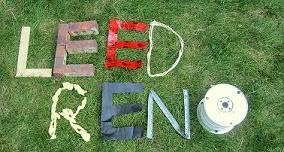In changing our kitchen from this:

to this:

... you have to get rid of a lot of material. In a traditional demo, you go in with a sledgehammer knock everything down and ship it off to a landfill.
Actually to be fair, I imagine most people would have saved the cabinets. But that probably would have been the extent of it. Our deconstruction meant carefully taking everything apart. Drywall came off and was bagged for recycling. Existing insulation was was cut out of the framing for future re-use. Lumber was salvaged and all the nails pulled out.
To most people reading this, I imagine the idea of slowly prying off 1/2" round trim and pulling out all the finishing nails seems fairly crazy and two years ago (when we did our last reno) the idea never even occurred to me. But it is probably the same way everyone felt back in the 80's when people started suggesting we wash and sort our garbage. Since that time recycling has become second nature to most of us.
So why bother? As mentioned at the start we tore 1713lbs of material out of our kitchen. This is what made it to the landfill:

one 42 pound bag of garbage. So over 97% of the waste was diverted. Where did it end up?
827 lbs of drywall: to be recycled
20 lbs of insulation: to be reused
487 lbs of cabinets/counters: to be sold
22 lbs of metal corner bead: to be recycled
5 lbs of nails / screws: 20% reusable, 80% recycling
111 lbs of lumber: to be reused
137 lbs of plywood: to be reused / given away
54 lbs of trim: to be reused
10 lbs of electrical: aluminum wiring to be recycled, boxes and face plates re-used
40 lbs hood fan: to be sold

When it comes down to it, some of the above material will end up being waste. As an example some of the lumber will need to be trimmed because of damage but a huge chunk will have been diverted. Apart from generating less garbage there are some financial benefits to deconstruction as well: no dump fees and for every piece of material I reuse whether its a electrical outlet or a 2x4 I am saving cash.
The flip side; deconstruction takes twice as long as a demolition and is half as fun. So you need to evaluate your own project and patience to determine how much effort you are willing to invest.
In this post you'll notice there has been no reference to LEED points. I am disappointed to say that is because there are none. There is a prerequisite to document my diversion rate for demolition but points are only awarded for diverting construction waste (packing materials, drywall waste, etc.).

For everyone wondering, the wall in the middle of the shot is coming down. We just need to convince the city it is non-load bearing.
ReplyDelete